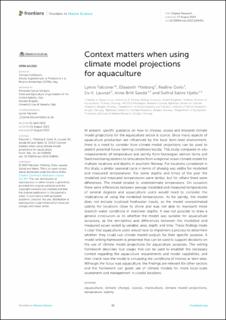| dc.description.abstract | At present, specific guidance on how to choose, assess and interpret climate model projections for the aquaculture sector is scarce. Since many aspects of aquaculture production are influenced by the local farm-level environment, there is a need to consider how climate model projections can be used to predict potential future farming conditions locally. This study compared in-situ measurements of temperature and salinity from Norwegian salmon farms and fixed monitoring stations to simulations from a regional ocean climate model for multiple locations and depths in southern Norway. For locations considered in this study, a similar seasonal cycle in terms of phasing was visible for modelled and measured temperatures. For some depths and times of the year the modelled and measured temperatures were similar, but for others there were differences. The model tended to underestimate temperature. On occasion there were differences between average modelled and measured temperatures of several degrees and aquaculture users would need to consider the implications of using the modelled temperatures. As for salinity, the model does not include localized freshwater inputs, so the model overestimated salinity for locations close to shore and was not able to represent more brackish water conditions in shallower depths. It was not possible to draw a general conclusion as to whether the model was suitable for aquaculture purposes, as the similarities and differences between the modelled and measured values varied by variable, area, depth, and time. These findings made it clear that aquaculture users would have to implement a process to determine whether they could use climate model outputs for their specific purpose. A model vetting framework is presented that can be used to support decisions on the use of climate model projections for aquaculture purposes. The vetting framework describes four stages that can be used to establish the necessary context regarding the aquaculture requirements and model capabilities, and then check how the model is simulating the conditions of interest at farm sites. Although the focus was aquaculture, the findings are relevant for other sectors and the framework can guide use of climate models for more local-scale assessment and management in coastal locations. | |
